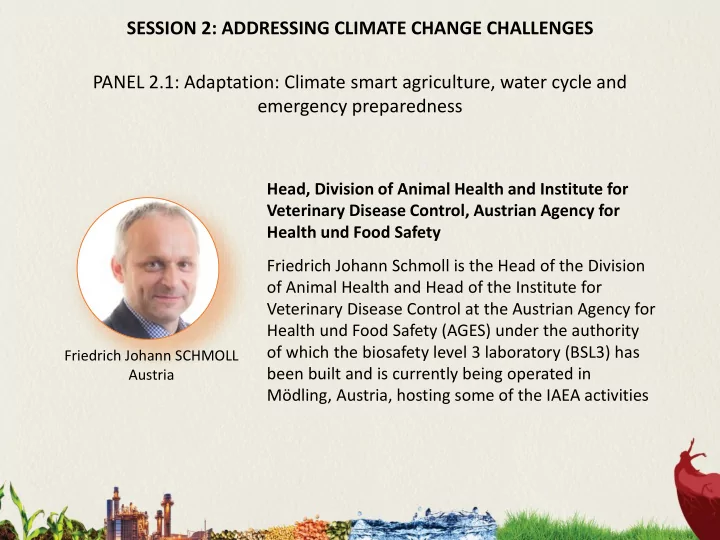

SESSION 2: ADDRESSING CLIMATE CHANGE CHALLENGES PANEL 2.1: Adaptation: Climate smart agriculture, water cycle and emergency preparedness Head, Division of Animal Health and Institute for Veterinary Disease Control, Austrian Agency for Health und Food Safety Friedrich Johann Schmoll is the Head of the Division of Animal Health and Head of the Institute for Veterinary Disease Control at the Austrian Agency for Health und Food Safety (AGES) under the authority of which the biosafety level 3 laboratory (BSL3) has Friedrich Johann SCHMOLL been built and is currently being operated in Austria Mödling, Austria, hosting some of the IAEA activities
Influences of climate change on emerging and re-emerging animal and zoonotic diseases; and the role of nuclear technology in this context Prof. Dr. Friedrich Schmoll Institute for Veterinary Disease Control Mödling
climate change animal and zoonotic diseases; Climate change provides more suitable environments for infectious diseases allowe disease-causing bacteria, viruses, and fungi to move into new areas where they may harm wild life and domestic species, as well as humans Pathogens can invade new areas and find new susceptible species as the climate warms and/or the winters get milder Insect-borne diseases are now present in temperate areas where the vector insects were non existent in the past e.g. trypanosomosis, anaplasmosis Humans are also at an increased risk from insect-born diseases such as malaria, dengue, and yellow fever
Vector Borne Disease (VBD) 3 elements must co-exist for the occurence of VBD Susceptible population • Migration (forced) • Vector environment Vector: most often arthropods Pathogen: • Survival • Survival, lifespan • Transmission • Reproduction/breeding patterns • Replication in host • Biting behavior
Vector Born Disease Mortality Distribution WHO, VBDs collectively account for more than 1.5 million human deaths per year (Hill et al., 2005).
Zika Virus Spread
Bluetongue (Ruminant) biting midge: Culicoides imicola 1st description 1905 in South Africa Culicoides biting midge Source: DEFRA
Bluetongue: Austrian vector monitoring for declaring seasonal vector-free period (Brugger et al., 2016 • Start of the seasonal vector-free period as of the beginning of December, and/or after 6 consecutive days with frost (T min < 0 ° C) • Ending of the seasonal vector-free period Catches with one Culicoides imicola or more than 5 (parous) Culicoides obsoletus and/or after 7 consecutive days with mean daily temperature > 10 ° C and so the beginning of the vector activity can be expected.
Vector monitoring 2017/18 Bluetongue: Austrian
the role of nuclear technology in context emerging and re-emerging animal and zoonotic diseases?
Cooperation: IAEA – AGES (AT) Our goals: health, food security, food safety Austrian Agency for Health & Food Safety Austria Center for Biosafety (L3+)
Cooperation: IAEA – AGES (AT) Our goals: health, food security, food safety rapid diagnostic techniques • developing and validating early and rapid diagnostic techniques: ELISA, PCR, real time PCR and sequencing 1. African Swine Fever, Lumpy skin Disease, Avian Influenca, … irradiation of pathogens for vaccine production e- / γ Virus Gamma/e-Beam irradiation nucleic acid destruction, high antibodies
Sterile Insect Technique - Mosquitoes Insect pest controle The SIT Package: • Mass rearing • Sex seperation, males • Sterilisation by irradiation • Packing, Transport • Release Mating sterile male with wild female Matings result in no offspring
Successful Uses of SIT to Manage Insect Pests False Codling Moth in Pink Bollworm in USA South Africa eradication suppression Mediterranean fruit fly in various countries Prevention, suppression, eradication
Univ.-Prof. Dr. Friedrich Schmoll Geschäftsfeldleiter Tiergesundheit AGES – Österreichische Agentur für Gesundheit und Ernährungssicherheit GmbH Robert-Koch-Gasse 17 A-2340 Mödling T +43 50555 38200 / M +43 664 9670940 friedrich.schmoll@ages.at www.ages.at
Irradiated Vaccine – killed Vaccine Gamma- / e-Beam Irradiation Virus Formalin viral destruction, low antibodies e- / γ Virus Gamma/e-Beam irradiation nucleic acid destruction, high antibodies
West Nile Virus Transmission Cycle
West Nile Fever Geographical shift between 2015 and 2018 2017-2018 2015-2016
Lumpky Skin Disease Transmission Caused by a virus from the - Direct contact family Poxviridae, genus - Vector arthropods (mechanical Capripoxvirus It is one of the biggest viruses - Secretions / excretions Skin and lung lesions (Credit: Noah's Arkive, PIADC) Mosquitoes (Aedes aegypti) Mosquitoes (Culex) Stable fly (Stomoxys calcitrans) Ticks, multiple species (Ixodes , Ripicephalus , Hyaloma , etc)
Lumpky skin disease distribution January 2006 – September 2016 2015-2016 2006-2010 2011-2014 2015-2016 Data source: FAO EMPRES-I (http://empres-i.fao.org/eipws3g/) Last access: 29 September 2016
Recommend
More recommend